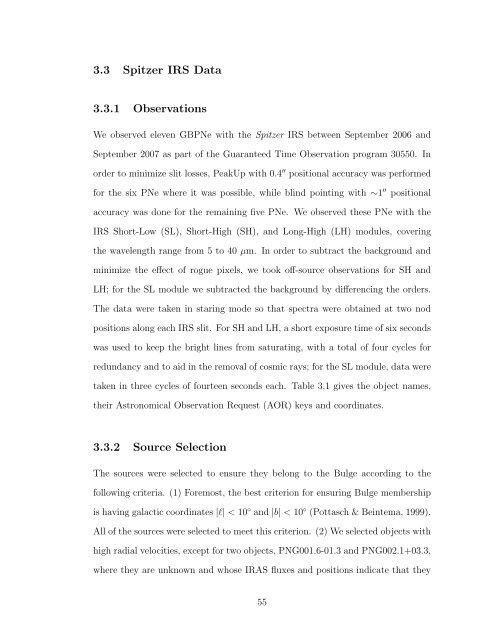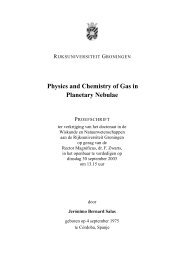TRACING ABUNDANCES IN GALAXIES WITH THE SPITZER ...
TRACING ABUNDANCES IN GALAXIES WITH THE SPITZER ...
TRACING ABUNDANCES IN GALAXIES WITH THE SPITZER ...
Create successful ePaper yourself
Turn your PDF publications into a flip-book with our unique Google optimized e-Paper software.
3.3 Spitzer IRS Data<br />
3.3.1 Observations<br />
We observed eleven GBPNe with the Spitzer IRS between September 2006 and<br />
September 2007 as part of the Guaranteed Time Observation program 30550. In<br />
order to minimize slit losses, PeakUp with 0.4 ′′ positional accuracy was performed<br />
for the six PNe where it was possible, while blind pointing with ∼1 ′′ positional<br />
accuracy was done for the remaining five PNe. We observed these PNe with the<br />
IRS Short-Low (SL), Short-High (SH), and Long-High (LH) modules, covering<br />
the wavelength range from 5 to 40 µm. In order to subtract the background and<br />
minimize the effect of rogue pixels, we took off-source observations for SH and<br />
LH; for the SL module we subtracted the background by differencing the orders.<br />
The data were taken in staring mode so that spectra were obtained at two nod<br />
positions along each IRS slit. For SH and LH, a short exposure time of six seconds<br />
was used to keep the bright lines from saturating, with a total of four cycles for<br />
redundancy and to aid in the removal of cosmic rays; for the SL module, data were<br />
taken in three cycles of fourteen seconds each. Table 3.1 gives the object names,<br />
their Astronomical Observation Request (AOR) keys and coordinates.<br />
3.3.2 Source Selection<br />
The sources were selected to ensure they belong to the Bulge according to the<br />
following criteria. (1) Foremost, the best criterion for ensuring Bulge membership<br />
is having galactic coordinates |ℓ| < 10 ◦ and |b| < 10 ◦ (Pottasch & Beintema, 1999).<br />
All of the sources were selected to meet this criterion. (2) We selected objects with<br />
high radial velocities, except for two objects, PNG001.6-01.3 and PNG002.1+03.3,<br />
where they are unknown and whose IRAS fluxes and positions indicate that they<br />
55













